The Fusion of Possibilities
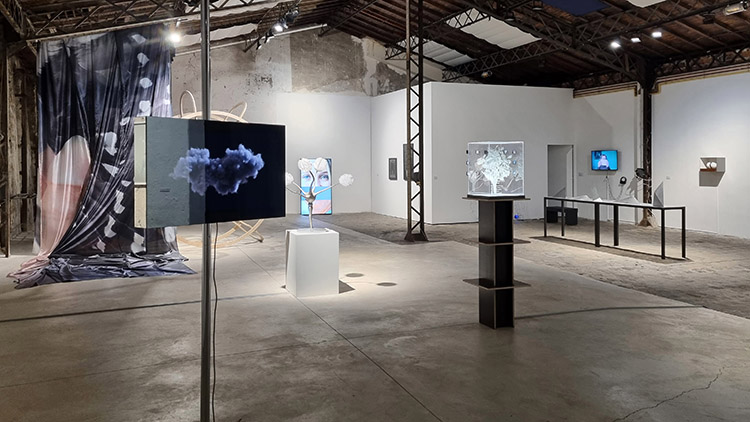
The Fusion of Possibilities, La Topographie de l’Art, April 15 to June 15, 2023.
Yesterday's possibilities are today's realities that we are constantly merging to make them even better. Over the last sixty years, many artists with a strong affinity for technology of their time have anticipated our environments or uses with their creations. It is often by hacking innovations that they innovate in turn when their multiple practices come together as their techniques agglomerate. From the scientific laboratory to the artist's studio, everything happens at the junction of the material and the immaterial, as well as that of intelligence and data, without forgetting the realities that are brought together by considering them extended. There is no longer an autonomous field of research, isolated from the others. In an age when the notion of artistic tendency is no longer operative, the exhibition The Fusion of Possibilities at the Topographie de l’Art, with artworks from converging practices, aims to be the expression of the symbiosis of ideas as well as of forms.
Experiencing perception
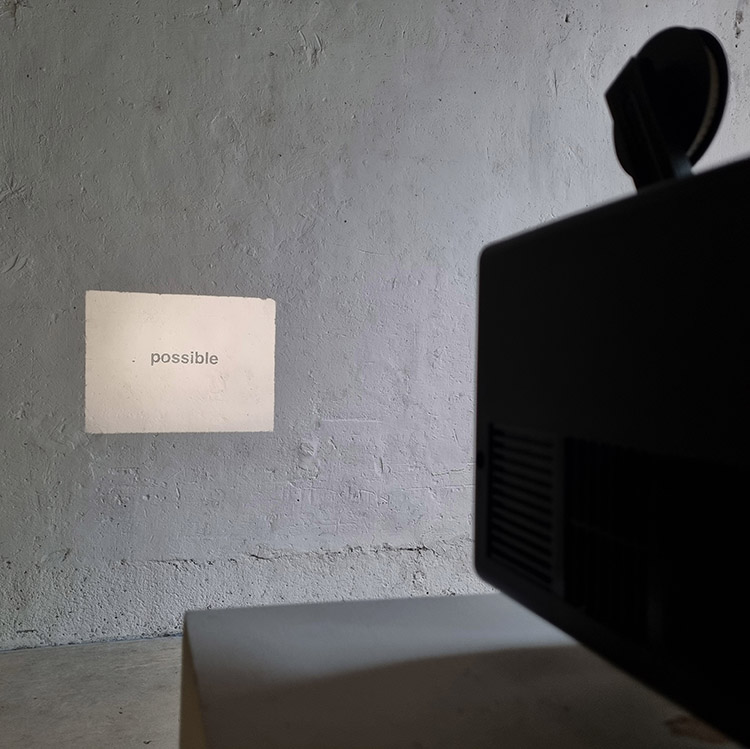
Peter Weibel, Possible, 1969.
If there are installations that open the fields of possibility, Peter Weibel’s is among them. It is in fact the adjective Possible that gives the installation its title and that is projected on the wall. But what a surprise for the public invited to cross the light of the cinematographic projector, when they realize the inability of their shadow to swallow the few typographical characters making up the adjective of all possibilities? The relevance of this light installation lies entirely in this moment of doubt that catches us off guard. At this very moment when the author of the artwork, which is emphatically perceptual, forces us to reason.
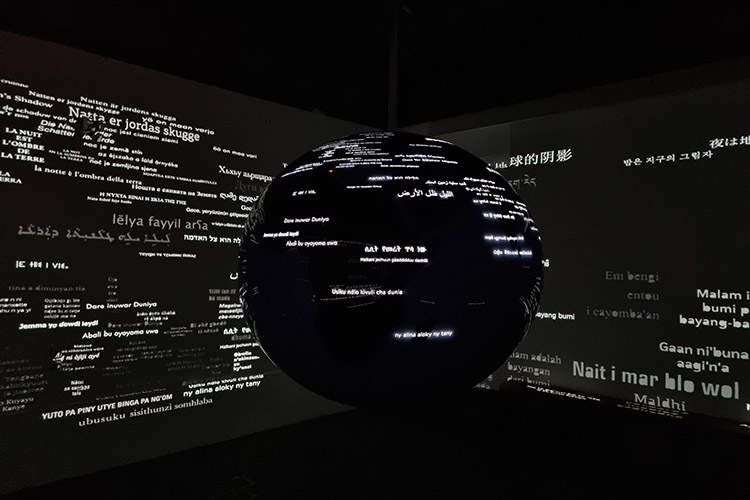
Vera Röhm, Globus, 2023.
The other installation, which is just as luminous but more immersive, and which also revolves around language, is Globus from the corpus Night is the Shadow of the Earth by Vera Röhm. This phrase by the German linguist Johann Leonhard Frisch obsesses her as much as it bewitches us when we grasp its extreme precision. And it is to underline its universality that the artist never ceases to translate it into a considerable number of known and unknown languages. Her way of evoking both the languages that separate us and this Earth that unites us, in this age when we are torn between the dream of inhabiting distant planets and the reality of a world of which we should take care.
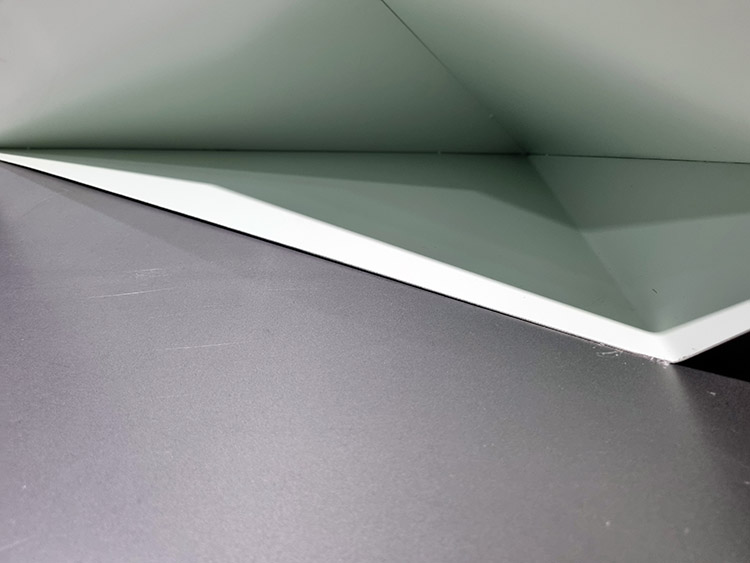
Victoire Thierrée, Azimut (detail), 2019.
With Victoire Thierrée, ambivalence gives way to the ambiguity of what we observe through a photographic print without understanding it. From inside a building, the point of view is external to what looks like an architecture whose scale tells us nothing. It is in fact a Shooting Simulator, and we learn the soothing virtue of the pale green that covers it. The color is like that of surgical blocks where it is known to remove the saturation of human blood. In the military context of the image, this hue appears to us as a strange attempt to de-dramatize war!
Media sculptures
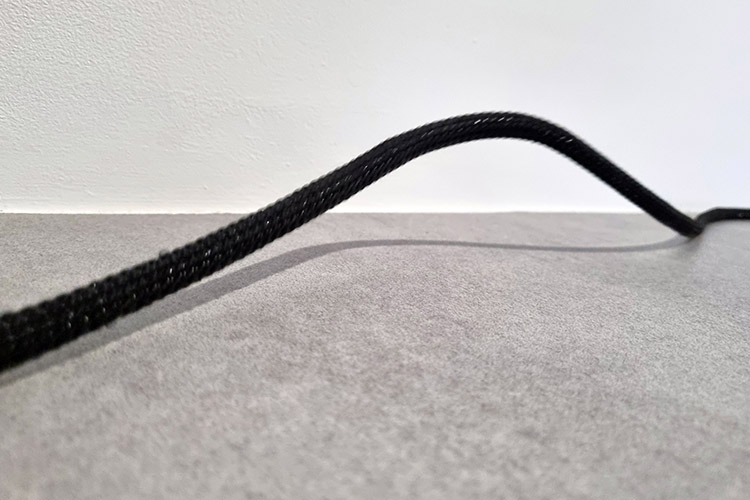
Samuel Bianchini, Snakable (detail), 2020.
With his video installation Snakable, Samuel Bianchini presents us with what is usually out of our sight, i.e., the back of a monitor where a wall delicately reflects the images that are being broadcast. The action takes place outside the frame but within our peripheral field of vision, where the cable, which we assume carries a video signal, contorts surreptitiously like a snake trying to free itself from a constraint. It is as if the main thread of what should be considered as a kinetic or, more precisely, robotic sculpture, was animated by the data thus conveyed, of which it would be, along with the screen and the wall, among the only witnesses.

Julien Maire, Artefacts, 2023.
With his Artefacts, Julien Maire transports us to the museum without us knowing where these objects come from, evoking a possible archaeology of the future. The nature of his forms or counter-forms oscillates between the cold roughness of essentially metallic materials, and the refinement of the luminous sparkles they emit. The variability of the effects thus produced evokes some form of language, as if these inert objects were addressing us, but to transmit what messages? Or perhaps we are not ready to interpret such flickering poetry while techno-nerds try to grasp the nature of such technological magic! As for the artist, he sees his creations as time killers announcing only themselves.
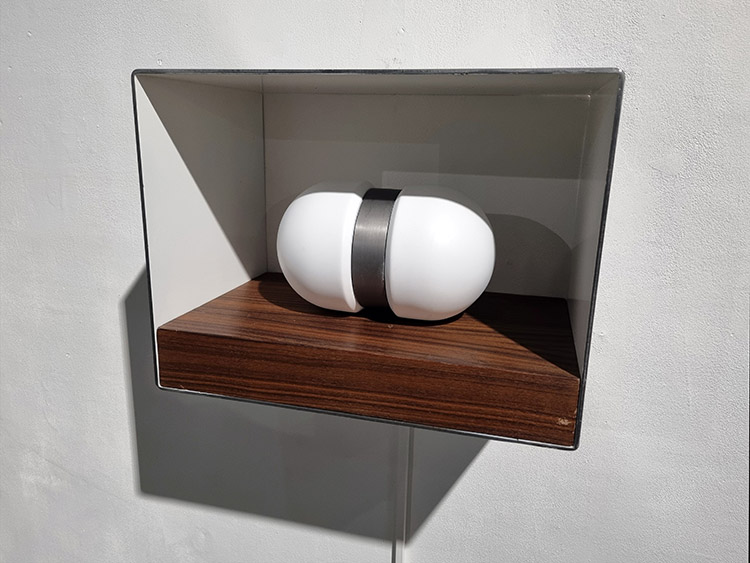
Michele Spanghero, Double Negative, 2020.
Michele Spanghero's Double Negative is another sculpture whose message, just as ‘hidden’, is audio. The message is internal to the object, transmitting vibrations to the box that contains it and forming an integral part of the installation. The original sound is none other than the sound signature of the artist's studio. This refers to the studio performances to which the artists bear witness through sounds or images. It is therefore the place of its emergence that makes the artwork. The latter continues to ‘perform’ in the exhibition space without us knowing how to interpret the signal. An appeal once again to the imagination of the spectators.
Undefined contours
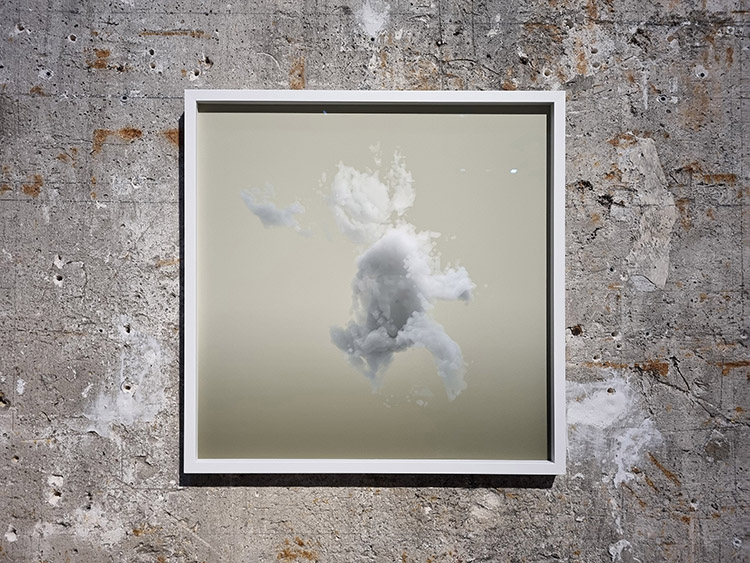
Thibault Brunet, 3600 secondes de lumière / N43 C47, 2022.
The clouds in Thibault Brunet's 3600 Seconds of Light series can be appreciated in different ways depending on the distance, so much so that they are photographic from afar and pictorial from up close. Yet they do not belong to either of these categories, since he acquired them as of three-dimensional models on websites for video game designers. Before assigning them their respective moments through an infinity of virtual lights. It is thus with a recurring theme in the history of art that the artist questions representation with the technology of his time. These ‘truer-than-life’ clouds, so perfectly framed, are pure fictions.
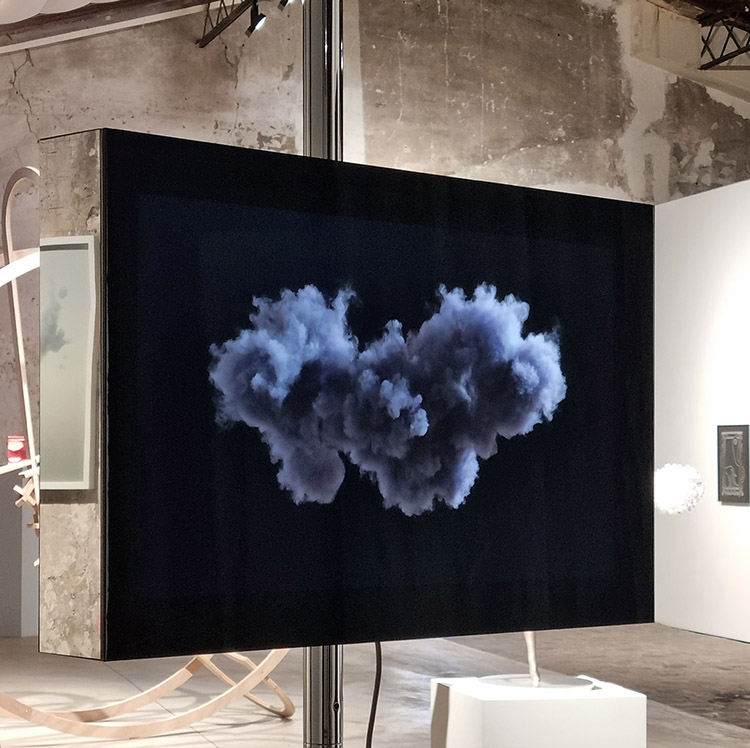
François Ronsiaux, The Cloud, 2020.
François Ronsiaux's The Cloud is just as fictional, although its context and state are different, since it is on top of a black background evoking absence, which it constantly metamorphoses. The disturbance, in this case, comes more from its apparent depth, which seems to go beyond the thickness of the video screen that serves as its backdrop. The fact that it is inscribed in time as well as in space gives it a singular presence. It is at the same time well at its place in the environment, which is dedicated to it and at the same time among us. As if we were sharing the same air, the same sky, in this era of reinforced cohabitation of virtual and real beings and objects.

Golnaz Behrouznia, Aquatilium, 2014-2023.
It is difficult to name what is immersed in the glass containers of Golnaz Behrouznia's Aquatilium series, whose aesthetics often evoke the life sciences. She thus reminds us of the essential role of observation, both in artistic creation and in scientific research. Initiated in the artist's studio-laboratory, these floating pieces only reach their fulfilment with the comments of the observers. Each of us thus projects ourselves into such abstractions, attempting to make personal interpretations that are only waiting to be exchanged with others. But isn't that what ideas are all about, in art as in science?
On nature and the living
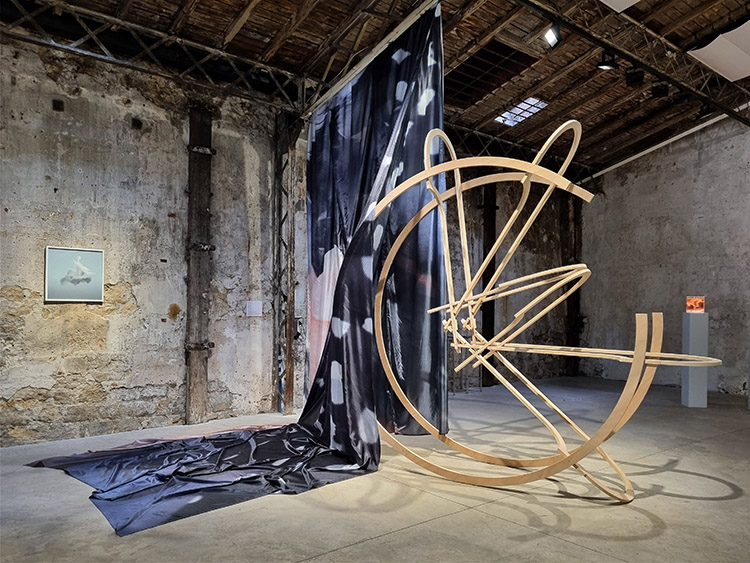
Marie Lelouche, Out Of Spaces, 2021.
Some creations are initiated by observation, while others require listening. This was the case with the installations in the Out of Spaces corpus that Marie Lelouche created during a residency as close as possible to what symbolizes nature so perfectly: birdsong. Her artworks are deployed both in the tangible space of the exhibition and in the virtual space accessed via a headset. There we find strange wire elements associated with large fabrics evoking feathers. Note that the cries of the birds animate the three-dimensional draperies which, freeing themselves from gravity, take us even further away from the weight of our bodies, from which the experience frees us.
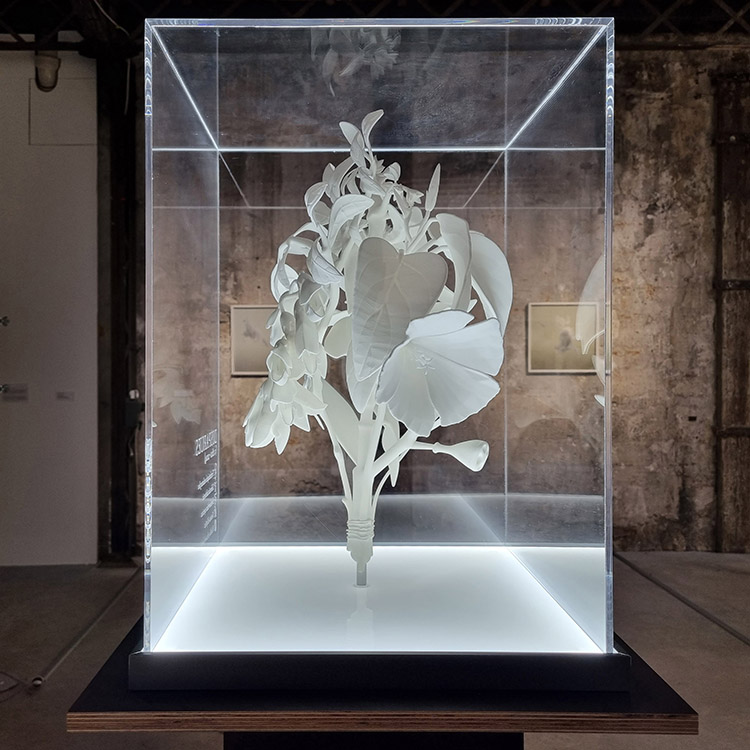
Donatien Aubert, Disparues - bouquet, 2020.
The showcase that protects the sculpture Disparues - bouquet from the corpus Cybernetic Gardens by Donatien Aubert propels us once again into a museum-like atmosphere. This is a fitting artwork display, when we learn that the five plants making up the assemblage have disappeared from the face of the earth. It is also interesting to note that the artist (re)discovered them by removing the powder that covered them due to the selective laser sintering technology used. In this way he revealed the contours of what he had previously modelled on scientific data with a meticulousness like that of archaeologists discovering traces of previous lives.

Marion Roche, Je viens de te voir en rêve, 2021.
Another sculpture refers to the living, the one entitled Je viens de te voir en rêve (I just saw you in a dream) by Marion Roche. Its metallic part evokes neurons as represented by the neuroscientists with whom she has collaborated. The endings are made up of shapes in hydrophilic material that are the result of a four-dimensional printing process and are the result of dreams that the artist has had during electroencephalography sessions. They transform on contact with water, unlike dreams which freeze on contact with light, interrupting them before consciousness reorganizes them, even if it means altering them a little, but to preserve them further.
The art of performance
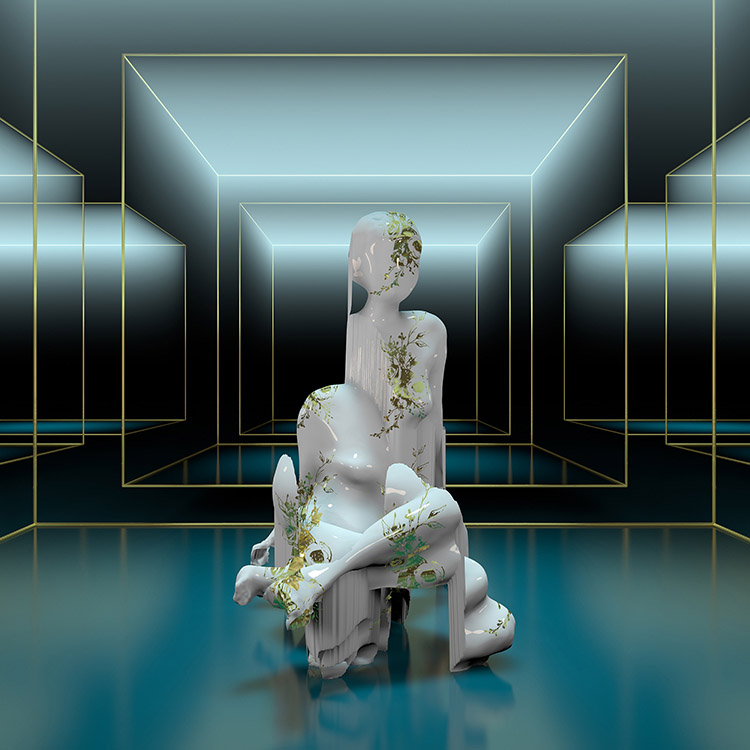
Sabrina Ratté, Monade, 2020.
Digital technology regularly reactivates artistic genres. This is the case with the prints in Sabrina Ratté's Monades series. Although they are three-dimensional self-portraits, they are truly the precise measurements of the artist, who obtained them by using photogrammetry. This body, which she literally mistreats by altering parts of it, is to be considered as her true imprint, with which she performs within constantly renewed virtual spaces. In doing so, she also reactivates the practice of self-shooting that contemporaries of the first portable video cameras initiated at the end of the 1960s.
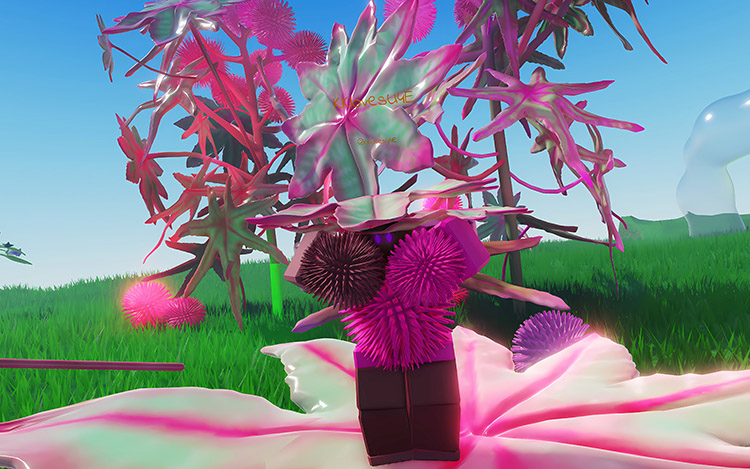
Kamilia Kard, Toxic Garden - Dance Dance Dance, 2022.
With Kamilia Kard, it is the gestures of the participants that are captured to animate their avatars within the online performances Dance Dance Dance of the Toxic Garden corpus. The beauty of the abundant nature of the gardens that the artist develops in the Roblox video game is matched only by the toxicity of the plants – such as the hemlock that caused the death of Socrates - that compose it, given the countless poisonings they have caused since ancient Greece. But the School of Athens, where people used to hold forth, is no more. Today, it is on social media that debates too often end in invective.
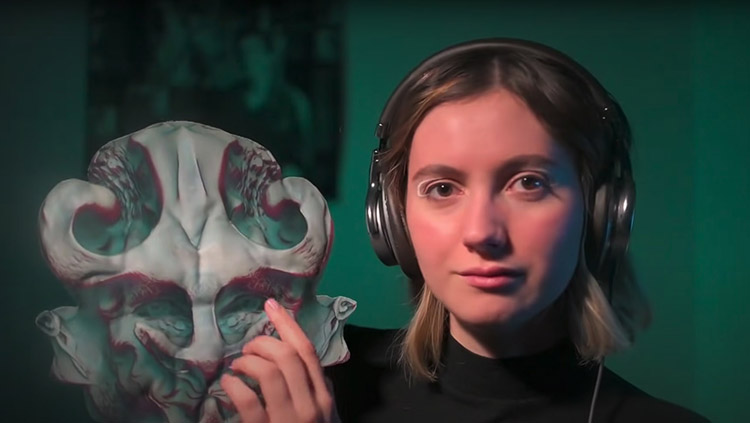
Caroline Delieutraz, Je te relaxe en touchant des œuvres
(en collaboration avec Behind The Moons), 2021.
Caroline Delieutraz, for her part, delegates her performance Je te relaxe en touchant des œuvres (I relax you by touching artworks) to the YouTube artist BehindTheMoons, known for her practice of ASMR, the acronym for ‘Autonomous Sensory Meridian Response’. Her works, like those of her artist friends, are appreciated only for the barely audible sounds they produce when handled with extreme delicacy. They are therefore visual artworks that participate in producing a sound art creation. The video sequence documenting the performance, strangely enough, really takes on its relaxing dimension when the audience, equipped with headphones, watches it with their eyes closed.
On the aesthetics of machines
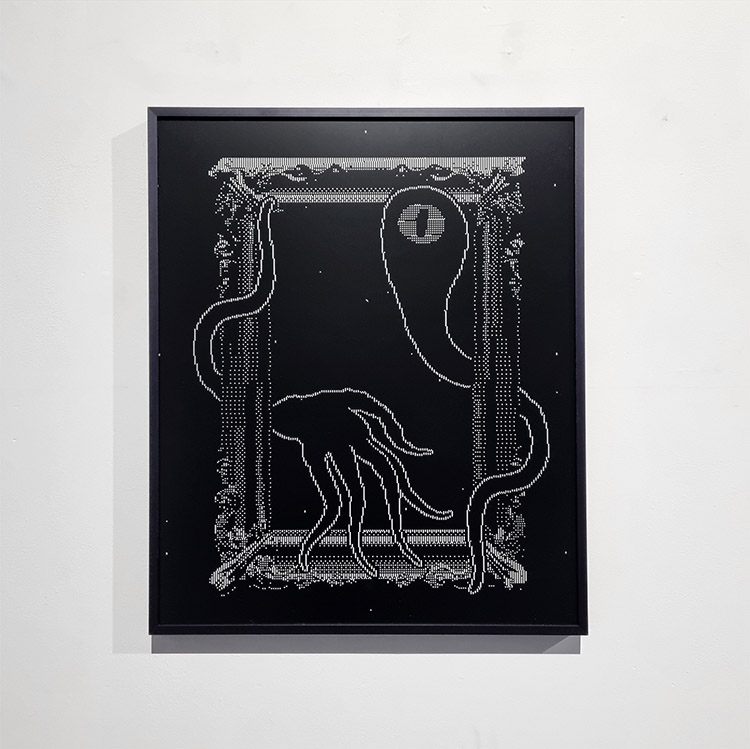
Nicolas Sassoon, Frame, 2020.
Nicolas Sassoon's work has a very marked unity of style. When his aesthetic echoes the limits, in terms of visual representation, that were inherent in the personal computers of the 1980s. The use of halftone patterns at that time was a necessity, whereas today this same immoderate use is a truly affirmed choice. It is the treatment, rather than the subject, which in the case of Frame or Plant makes the image, the artwork. To the point that, on the artist's website, patterns are presented that represent only themselves. This refers to other resolutely retinal practices, those of an optical art, which are constantly re-emerging.
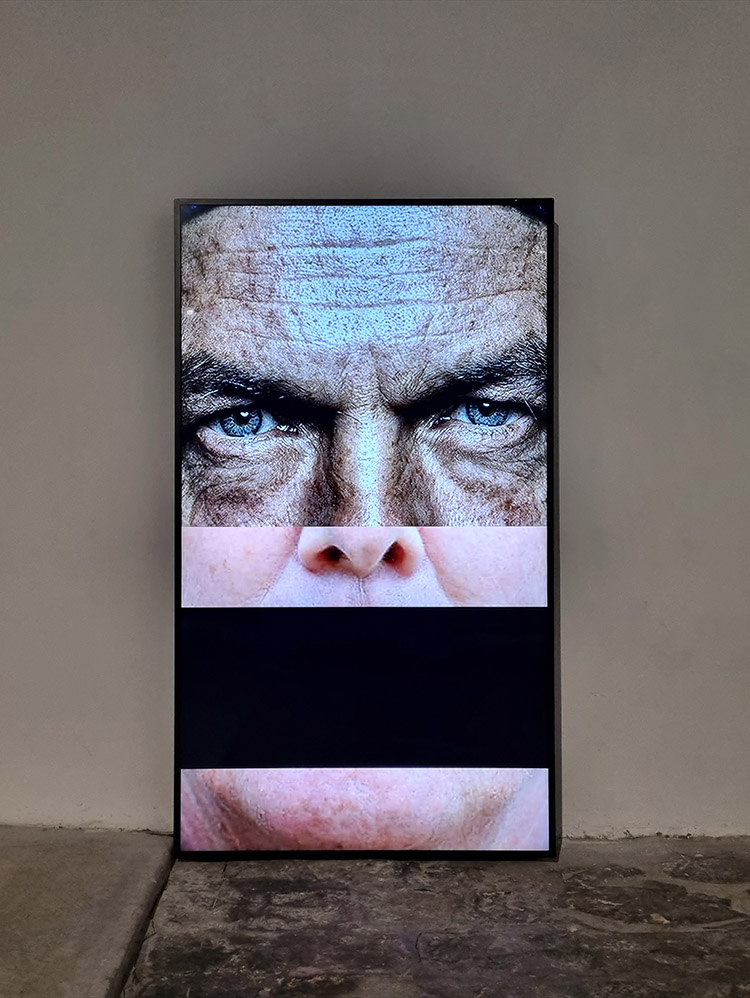
Pascal Dombis, I AM NOT A ROBOT, 2023.
Who today can claim to be able to dissociate a human from a machine in any situation when it is up to us to prove to the robots online that we are not? Pascal Dombis' installation I AM NOT A ROBOT is based on such questions. But it seems to us that the machine, in this case, is affected by a form of artificial doubt. A disorder that it expresses through bugs of various kinds. The bug can also be considered as the only opportunity for machines to free themselves from all control. Such a bug would thus signal the beginning of a program rather than its unexpected end. Fiction, which always precedes science, is full of such beginnings.

Albertine Meunier, HyperChips, 2023.
The last few years have been marked by the availability of artificial intelligence services, dedicated to the creation of images through text, to everyone. Albertine Meunier has fun with the non-clichés of her Hyperchips series. For the main debate emerging from this recent democratization concerns copyright. However, her images, beyond their perfectibility, all evoke the aesthetics of the English photographer Martin Parr. Which, however, the artist does not mention in her ‘prompt’. Meaning the short text that she tirelessly enters to obtain images before protecting them into NFTs, these new kinds of property titles.
Articles
- Paris Photo
- Art, technology and AI
- Immersive Art
- Chroniques Biennial
- 7th Elektra Biennial
- 60th Venice Biennial
- Endless Variations
- Multitude & Singularity
- Another perspective
- The Fusion of Possibilities
- Persistence & Exploration
- Image 3.0
- BioMedia
- 59th Venice Biennale
- Decision Making
- Intelligence in art
- Ars Electronica 2021
- Art & NFT
- Metamorphosis
- An atypical year
- Real Feelings
- Signal - Espace(s) Réciproque(s)
- On Combinations at Work
- Human Learning
- Attitudes and forms by women
- Ars Electronica 2019
- 58th Venice Biennale
- Art, Technology and Trends
- Art in Brussels
- Plurality Of Digital Practices
- The Chroniques Biennial
- Ars Electronica 2018
- Montreal BIAN 2018
- Art In The Age Of The Internet
- Art Brussels 2018
- At ZKM in Karlsruhe
- Lyon Biennale 2017
- Ars Electronica 2017
- Digital Media at Fresnoy
- Art Basel 2017
- 57th Venice Biennial
- Art Brussels 2017
- Ars Electronica, bits and atoms
- The BIAN Montreal: Automata
- Japan, art and innovation
- Electronic Superhighway
- Lyon Biennale 2015
- Ars Electronica 2015
- Art Basel 2015
- The WRO Biennale
- The 56th Venice Biennale
- TodaysArt, The Hague, 2014
- Ars Electronica 2014
- Basel - Digital in Art
- The BIAN Montreal: Physical/ity
- Berlin, festivals and galleries
- Unpainted Munich
- Lyon biennial and then
- Ars Electronica, Total Recall
- The 55th Venice Biennale
- The Elektra Festival of Montreal
- Digital practices of contemporary art
- Berlin, arts technologies and events
- Sound Art @ ZKM, MAC & 104
- Ars Electronica 2012
- Panorama, the fourteenth
- International Digital Arts Biennial
- ZKM, Transmediale, Ikeda and Bartholl
- The Gaîté Lyrique - a year already
- TodaysArt, Almost Cinema and STRP
- The Ars Electronica Festival in Linz
- 54th Venice Biennial
- Elektra, Montreal, 2011
- Pixelache, Helsinki, 2011
- Transmediale, Berlin, 2011
- The STRP festival of Eindhoven
- Ars Electronica repairs the world
- Festivals in the Île-de-France
- Trends in Art Today
- Emerging artistic practices
- The Angel of History
- The Lyon Biennial
- Ars Electronica, Human Nature
- The Venice Biennial
- Nemo & Co
- From Karlsruhe to Berlin
- Media Art in London
- Youniverse, the Seville Biennial
- Ars Electronica, a new cultural economy
- Social Networks and Sonic Practices
- Skin, Media and Interfaces
- Sparks, Pixels and Festivals
- Digital Art in Belgium
- Image Territories, The Fresnoy
- Ars Electronica, goodbye privacy
- Digital Art in Montreal
- C3, ZKM & V2
- Les arts médiatiques en Allemagne
- Grégory Chatonsky
- Le festival Arborescence 2006
- Sept ans d'Art Outsiders
- Le festival Ars Electronica 2006
- Le festival Sonar 2006
- La performance audiovisuelle
- Le festival Transmediale 2006
- Antoine Schmitt
- Eduardo Kac
- Captations et traitements temps réel
- Maurice Benayoun
- Japon, au pays des médias émergents
- Stéphane Maguet
- Les arts numériques à New York